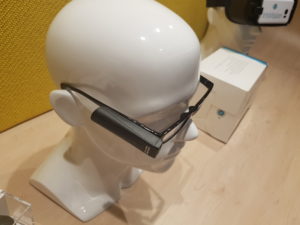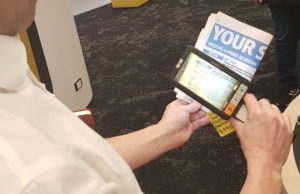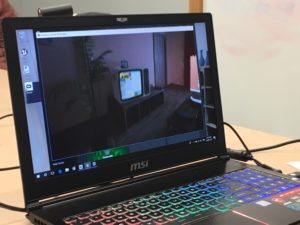On a windy Friday 13th the VE Design Team were lucky enough to spend the morning at Vision Australia’s recently redesigned headquarters in Kooyong.
The chief activity was to experience their virtual reality activity; to see what’s possible and effective for building Augmented and Virtual Reality (AR/VR) experiences into our courses notably the VR experiences our team are creating for the Future Social Services Institute project.
 The activity Vision Australia developed used an Oculus Rift to offer a seated activity which simulated different degenerative and visual impairments. Vision Australia’s Cate Keane walked us through the scenario and what it aimed to achieve. Using analog methods to recreate eye conditions, the 3D immersive activity provided us with an experience, and greater understanding, of vision impairment.
The activity Vision Australia developed used an Oculus Rift to offer a seated activity which simulated different degenerative and visual impairments. Vision Australia’s Cate Keane walked us through the scenario and what it aimed to achieve. Using analog methods to recreate eye conditions, the 3D immersive activity provided us with an experience, and greater understanding, of vision impairment.
The task required us to assume the role of an older man with macular degeneration who was trying to contact his daughter via Skype. It brilliantly illustrated this as a difficult task, attempted in a typical living room with poor lighting. The activity required us to then attempt the activity after several assistive technologies and improved lighting had been applied. These interventions are typical of the recommendations Vision Australia would make to improve the accessibility of the person’s home. This ‘before’ and ‘after’ task showed how simple some of the interventions were, and how much benefit they could offer someone with low vision.
 The activity was incredibly successful in highlighting how the granular nature of different types of visual impairments may affect someone’s daily activities. Building empathy was a welcome side effect of the exercise —something we’re aiming to reproduce in our planned activities.
The activity was incredibly successful in highlighting how the granular nature of different types of visual impairments may affect someone’s daily activities. Building empathy was a welcome side effect of the exercise —something we’re aiming to reproduce in our planned activities.
As this task was a solo activity, the rest of the team were able to tour the complex which had recently undergone redevelopment and now provides a suite of sensory inclusions. The building itself has notable (and tasteful) high contrast surfaces and wall edges to assist low vision staff and guests to navigate around the building. Corridors in the headquarters have tactile carpeted walls which encourage non visual tactile feedback. Our own accessibility guru Michael Grant has previously written about the importance of high contrast interfaces in a digital context, so it was reinforcing to see these applied in a real life example. Vision Australia actively aims to employ and preference “…candidates who are blind or have low vision.” as part of their careers’ schedule.

The Vision Australia Shop captured much of our time while we took turns on the VR activity. Orthoptist and products advisor Tony Wu took us through the devices that were designed to assist people with low vision, better manage activities of daily living.
Equipment for testing and sale included a few dozen magnifying devices, from simple glass magnifying glasses, and tech that goes back to before the 0 AD; to bleeding edge digital magnifying screens with colour and contrast control.
Wearable audio text readers we an instant hit, as we tested their ability to read print. Facial recognition cameras also enabled a user to be informed who was standing in front of them if that person has been saved to the device’s database.
The most encouraging takeaway was to see the variety of devices available. In a modern consumer context, we often only seek out the ‘best’ item available on the market. The broad range of devices on display showed that peoples’ varying needs could be met by the most appropriate assistive device. Tony’s direction was helpful in explaining how devices would be suited to different situations.
In 2016, Vision Australia estimated there are 384,000 people in Australia who are blind or have low vision. Compounded by an ageing population, VA estimates that over half a million will be in these categories by 2030. These numbers are indicative of the importance of an inclusive workforce and sympathetic interface design, real and online.
The return home saw us all comment on the motorbike hazardly parked on the footpath, now consciously recognising it as an impediment to low vision people. Only a few hours prior we would have walked past it without comment. The morning’s visit had already affected our working understanding of the importance of empathy for those with low and no vision.